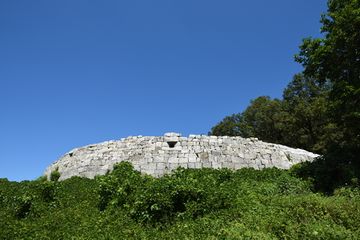굴암돈대
| 굴암돈대 Guramdondae Outpost |
|
| 대표명칭 | 굴암돈대 |
|---|---|
| 영문명칭 | Guramdondae Outpost |
| 한자 | 屈岩墩臺 |
| 주소 | 인천광역시 강화군 양도면 하일리 산98 |
| 지정(등록) 종목 | 인천광역시 기념물 제39호 |
| 지정(등록)일 | 1999.03.29 |
| 분류 | 유적건조물/정치국방/성/성곽시설 |
| 소유자 | 기획재정부 |
| 시대 | 조선 |
|
|
|
해설문
국문
돈대는 적의 움직임을 살피거나 공격에 대비하기 위해서 감시가 쉬운 곳에 설치하는 초소이다. 밖은 성곽을 높게 하고 안은 낮게 하여 포를 설치해 두는 시설물로, 대개 높은 평지에 쌓는다.
이 돈대는 조선 숙종 5년(1679)에 강화유수 윤이제가 해안 방어를 목적으로 축조한 여러 돈대 중의 하나로 정포보(井浦堡)에 속했다. 높이 3m, 둘레 70m의 타원형에 가까운 형태로, 대포를 올려놓는 포좌를 4곳에 설치하였다. 돈대 위에는 몸을 숨기고 적을 공격하기 위해 덧쌓은 낮은 담장을 두른 흔적이 있었으나 현재는 남아 있지 않다.
영문
An outpost, called dondae in Korean, was a small camp set up at a distance from a main military station. It was used to monitor the enemies’ movements and to stand guard against unauthorized intrusions and surprise attacks.
In 1679, during the Joseon dynasty, Minister of Military Affairs, Kim Seok-ju (1634-1684), recommended the construction of military outposts in Ganghwado Island to King Sukjong. A local magistrate, Yun I-je (1628-1701), oversaw the construction of 48 outposts. Six additional outposts were built later. These outposts were constructed on the coastal upland of Ganghwado, with artillery emplacement surrounded by high stone walls.
Guramdondae was an outpost of Jeongpobo Fort. It has four artillery emplacements, and its stone walls form a semi-circle shape, measuring 3 m in height and the circular section of the outpost is approximately 70 m in length. There are traces of low walls above the main structure which shielded soldiers during battle.
- 국문 문안에서는 ‘강화유수 윤이제가 돈대를 축조하였다’라고만 언급했지만, 영문 문안에서는 ‘강화 돈대는 조선 숙종 5년(1679년) 병조판서 김석주의 건의로 축조되었으며 윤이제는 실제 축성을 지휘했다’라고 하여 돈대의 축조와 관련한 역사적인 배경을 좀 더 구체적으로 설명함.
